In a city like Chicago, Rosehill Cemetery can come across odd. Such places don’t seem a part of any metropolis, but rather a rustic respite from one. Coming through the towering stone gates is like entering another dimension, a place where the urban world gets left behind. The presence of deer prancing between graves, nibbling the grass and memorial flowers adds to Rosehill’s surreal beauty. Perhaps that’s part of what makes the cemetery so haunting. It’s a world outside the world within the city.
Here the ghosts of retail behemoths carry on their lifelong feuds. The victorious dead howl in the night. Mysterious fog fills a glass case, shrouding the statue within. The smell of flowers lingers even in the dead of winter. Ladies seen along the grave lanes vanish when approached. There is no shortage of possible specters at Rosehill Cemetery.
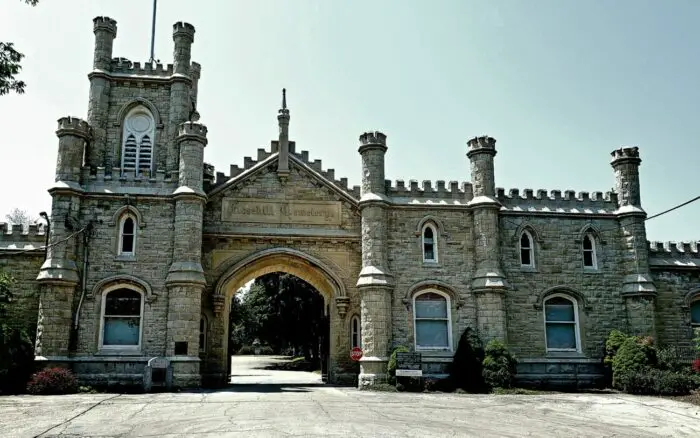
Located in Chicago’s North Ravenswood neighborhood, the history of Rosehill Cemetery already begins with myth. The origins of the name haven’t exactly been nailed down. The popular legend is that a person named Hiram Roe used to own the land which was then known as Roe’s Hill. When a cemetery endeavor sought to purchase the property, the name got mislabeled for whatever reason as Rosehill.
Historical records do contain the existence of a fellow named Hiram Roe. “History of Cook County, Illinois: From the Earliest Period to the Present Time” mentions him owning a plot of land and having a ready supply of “whisky for the accommodation of the settlers on their way to and from Chicago.” However, there is no recorded association with the Rosehill Cemetery Company founded February 11th, 1859. Historian Adam Selzer, writing for mysteriouschicago.com, believes the two separate facts may’ve amalgamated into the myth of Rosehill’s name, partially due to a similar incident described in “The Northmen in Cumberland & Westmoreland” by Robert Ferguson.
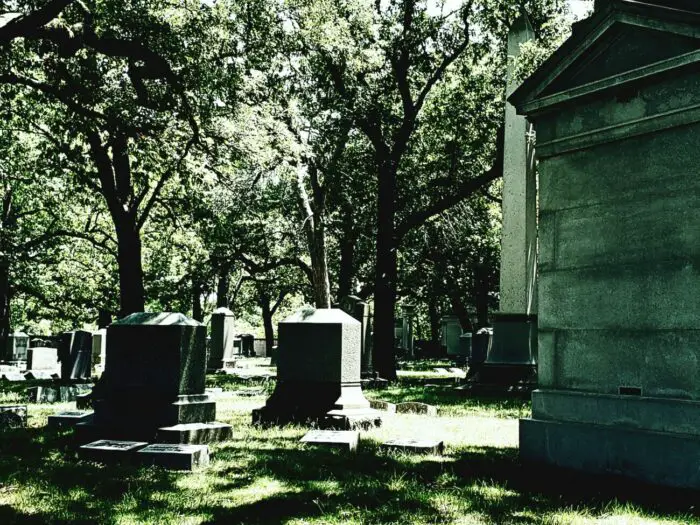
Still, the legend of Rosehill Cemetery’s name tends to be more popular than the nebulous unknowable past. Tour guides can be forgiven for supposing a cemetery business approached a whisky peddler named Hiram Roe. He only agreed to sell Roe’s Hill after insisting in Chicago fashion that the land be named after him. However, for whatever reason, someone wrote it down wrong, and the place became Rosehill Cemetery.
The 350-acre graveyard would be incorporated in 1859, and its castle-like arched stone entrance added in 1864. Designed by William Boyington, best known for creating the landmark Chicago Water Tower on Michigan Avenue, it’s a storybook divide. Like something out of a grim fairytale, the archway of Joliet-limestone allows entrants into Rosehill Cemetery. It’s otherworldly in the modern era. Yet, the ideal starting point for graveyard adventurers.
Once through the roads narrow to lanes that accommodate cars, though they’ve clearly not been designed for such conveyance. The open-air nature of the expansive park-like cemetery means street sounds dissipate quickly. Nothing to bother those strolling the grounds, and easily ignored. Trees abound as do small ponds, and though hardly hilly, the grounds have the navigable unevenness of wavy prairies.
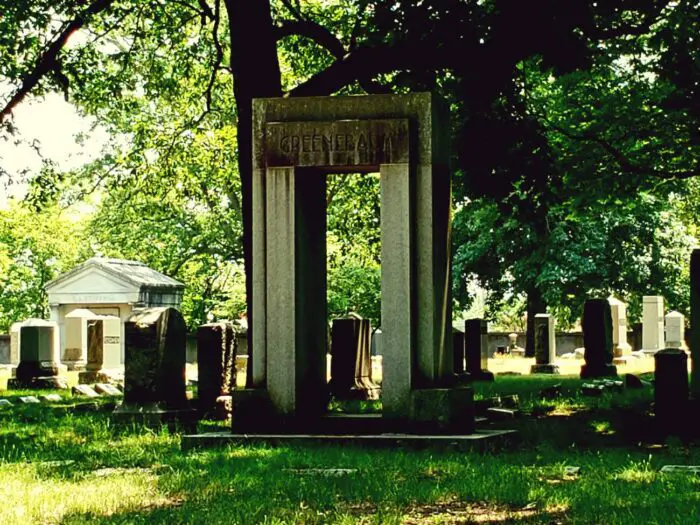
I can honestly say Rosehill Cemetery is one of the most peaceful graveyards I’ve ever visited. Perhaps plowing through the construction congestion on Peterson Avenue added to such a sentiment. However, I’d like to think the place is serene due to what it seems to prove. Rosehill Cemetery has the look I’m sure many have envisioned imagining graveyards while reading Gothic tales. Where Poe’s raven might observe Robert Louis Stevenson’s body snatchers working for a nearby Dr. Frankenstein. It’s the kind of place that seems to prove fantasies aren’t far from facts.
Over the years, several Chicago historical figures have made Rosehill Cemetery the place of their final repose. Individuals such as John G. Shedd whom the famous Shedd Aquarium is named after, Narcissa Niblack Thorne, the artist behind the Thorne Miniature Rooms, and meat magnate Oscar Mayer. Fourteen Chicago mayors are interred here like Harvey Doolittle Colvin who was in office during the Chicago Fire of 1874 (not to be confused with the Great Chicago Fire in 1871), as is George B. Armstrong, the Chicago postmaster who revolutionized mail through rail. Essentially, Rosehill Cemetery became a place to plant the dead who expected their memory to blossom and branch throughout time. The architecture of their graves certainly speaks to such a mentality. Consider railroad president Darius Miller, who ended up in an Egyptian Revival-style mausoleum. It’s no wonder ghost sightings involve some of these men haunting their costly graves.

Such is the case with Charles Hopkinson, a wealthy real estate investor who died on January 7th, 1883. The widow Mary Hopkinson got permission from Rosehill Cemetery to erect an above-ground mausoleum. However, once building began, some felt the structure was too titanic a tomb. Rosehill soon ordered construction halted. Claims the intended crypt would ruin the view for surrounding graves compelled Mary to sue, and she eventually won her case allowing her to finish the structure. It’s said that victory inspires her deceased husband to howl in delight every anniversary of his death.
Though grand in its own way, Hopkinson’s crypt is nothing compared to the Community Mausoleum of Rosehill Cemetery. According to “Graveyards of Chicago: The People, History, Art, and Lore of Cook County” by Matt Hucke and Ursula Bielski, it is “the single most impressive cemetery experience to be had in the Chicago metropolitan area… designed in 1914 by Sydney Lovell, the massive structure is a multi-level maze of marble-lined passageways stacked to the ceilings with thousands of the dearly departed.” Within those walls are several noteworthy individuals which causes some issues if ghost stories are to be believed.

The remains of retail royalty reside inside the Community Mausoleum. Specifically, the bodies of Richard Warren Sears and his rival Aaron Montgomery Ward. Roughly speaking, for those too young to recall the once-dominant retailers, it would be like if Amazon and Alibaba had a more openly bitter relationship. Ghost sightings allege that Sears is none too pleased to be sharing the same space as his deceased competitor. His specter supposedly stalks the mausoleum, angrily stomping toward Ward’s crypt.
That said, the most famous hauntings have nothing to do with Chicago aristocrats. Two statues housed in glass have been the focal point of many ghost hunts over the years. These are the sculptures memorializing Frances Pearce and Lulu Fellows.
Considered the most photographed statue in Rosehill Cemetery, the monument to Frances Pearce is a sad story. It’s a shrine not only to her memory but her infant daughter as well. The two died tragically young. After giving birth in July of 1853, nineteen-year-old Frances Pearce passed away eight months later. Shortly thereafter, her daughter died as well. The exact cause of death for the mother and ten-month-old is unknown as records were lost in the Great Chicago Fire of 1871. Survived by her husband, Horatio Stone, it was he who commissioned the statue that stands in Rosehill Cemetery.
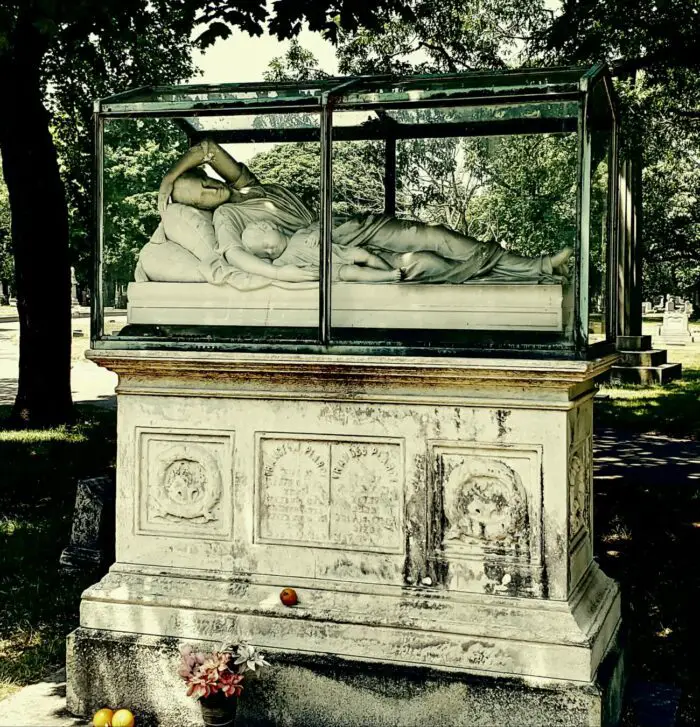
It’s a captivating sculpture. The kind that transfixes an observer because at any moment it seems like it’ll move. As if the figures are simply slumbering and might shift to a more comfortable position. The glass is all that keeps the wind from rippling their clothes. The reclining mother holding an infant child is a mute yet evocative memorial to the loss. Fortunately, when the sculpture was moved from the old city cemetery to Rosehill, it was decided that a glass encasement should be added to protect it from the elements. As such, this statue has survived untouched for decades.
Sadly, even the tragic origins of this masterful monument aren’t unmarred by historical inaccuracy. For some reason, people tend to assert Frances died during childbirth and the infant followed shortly after. There’re also claims the sculpture in Rosehill was commissioned to replace one lost when the Lusitania sank. Both are contradicted by the remaining historical records, particularly the Lusitania association since the statue was finished in 1859 and the famous ship sank in 1907.
If my experiences are worth anything, some folks just can’t resist adding a little extra seasoning to ghost stories. The sad part being the debunkable facts diminish the credibility of other claims. For it’s been said that on the anniversary of Frances’ death, the glass case surrounding the sculpture fills with a mysterious mist.
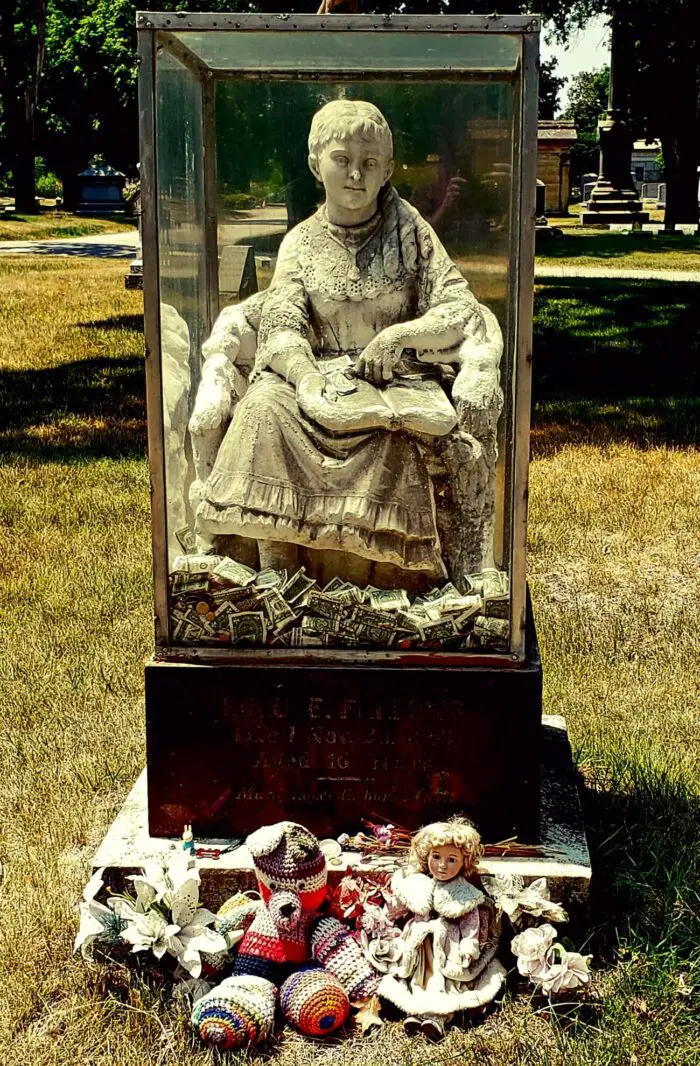
Similarly, there’s the sculpture of Lulu Fellows. The glass-boxed statue is a memorial to the young elocutionist. That is to say, her profession involved performing acts of spoken word, sometimes to accompanying music. As a teenager, Lulu contracted Typhoid Fever and died within a week. Her parents erected the sculpture in her memory. Holding a book in her lap, Lulu overlooks the graves of her family. Rosehill Cemetery decided to put up the glass encasement, and though some weather damage has occurred, it’s nothing to diminish the quality of the sculpture.
This is another one that can feel eerie to look at. Perhaps having the paranormal in mind only makes it seem so. Still, it’s clearly an often-visited site. People leave gifts of children’s toys, and an opening in the box allows cash donations. I’ve heard the supposition money is a requirement for anyone photographing Lulu Fellows, or else some type of bad luck curse will ensue. Frankly, I attribute that to the type of folks who overseason a spook story. After all, the more often heard supernatural here is that the place always smells like flowers, even in the dead of winter. And I can’t deny it didn’t smell accordingly while there.
Finally, there is the classic account of a vanishing woman. The story goes that a groundskeeper hurried out of the administrative building after seeing someone wandering the grave lanes. This being after hours when Rosehill Cemetery is closed to the public. Approaching the woman, he observed her leaning against a tree near the Peterson Avenue wall. But when the groundskeeper approached the lady vanished into thin air.
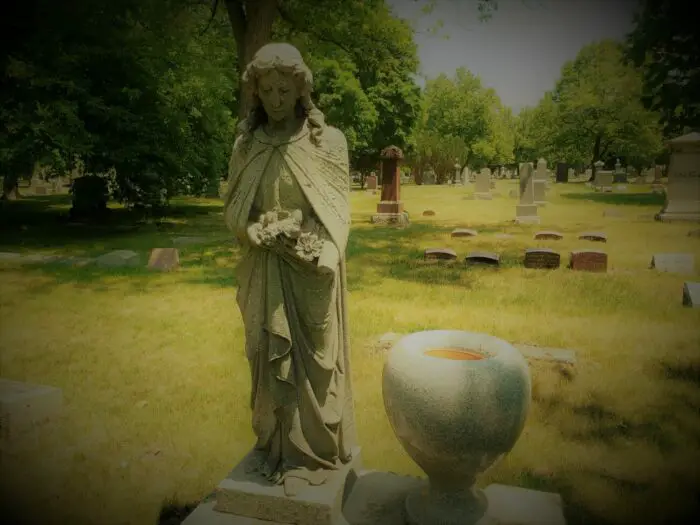
Supposedly, the next day someone from Des Plaines called. A ghostly visitation from a dead aunt demanding a grave marker prompted them to put a proper stone in place. It just so happened to be near the tree where the spectral lady vanished. And she has not been seen since.
Strange voices in the Community Mausoleum. Mysterious mist in glass boxes. Perpetual flower aromas, and vanishing spectral aunties. It may not seem like much, but it should be kept in mind Rosehill Cemetery isn’t generally open to the public. There are visiting hours as well as the occasional historical walking tour and Halloween fun run, but people aren’t typically here at night. In my opinion, that diminishes the odds, not so much because ghosts operate during certain hours, but rather, the likelihood of misinterpreting events is significantly lower.
I know from personal experience, walking along Peterson Avenue, it’s possible to look through the barred gates and see movement within. For a second it can seem paranormal until passing cars spill light inside revealing the strange shadowy movements are just the local deer living in Rosehill Cemetery. Howling winds in winter aren’t uncommon in Chicago, so no surprise such sounds are heard on the January anniversary of Hopkinson’s death. The glass around Frances Pearce isn’t hermetically sealed, so the simple mechanics of condensation and fog lend some explanation. Still, Rosehill Cemetery is typically a jumping-off point for late-night bar banter.
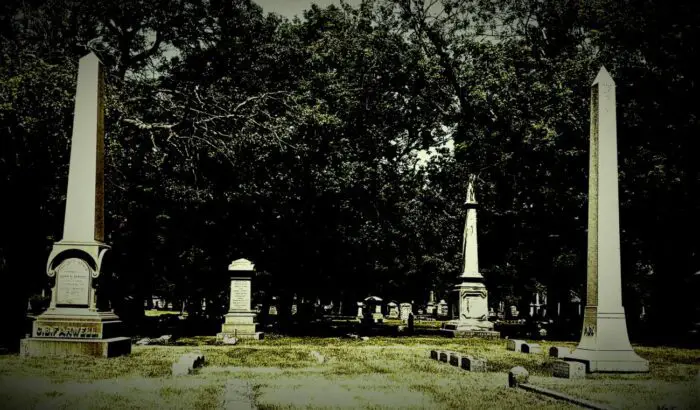
I’ve enjoyed many a long evening at a dive speculating about spooks simply because we first passed Rosehill en route to wherever. The urban legends flow with the cups and a tangle of Graceland, Rosehill, and Bachelor’s Grove enriches the evening. After all, whatever the reality, Rosehill Cemetery is certainly a place that haunts and inspires the imagination. Here Gothic horror seems on the verge of reality, but there are also those kinder ghosts such as Lulu Fellows and her flowers. The point being, Rosehill Cemetery is worth a visit for those seeking a supernatural atmosphere. And who knows what you might witness?




One night around 1:00am while walking my dog along Ravenswood the person I was with and I heard the distinctive sound of a horse whinny. The trains were not running that late so it wasn’t a train noise. The dog instantly was terrified and quickly turned around. I got a spooky feeling and we immediately left the area.
I spoke to someone else about the incident and he said in the early days of the cemetery horses pulled the coffins into the cemetery.